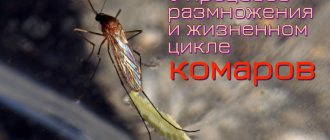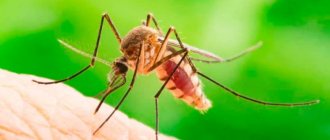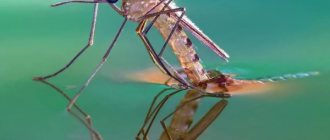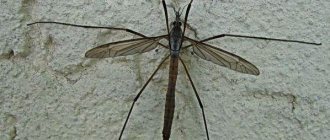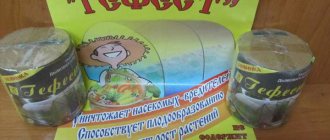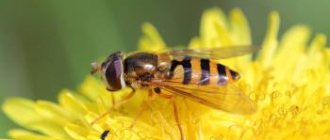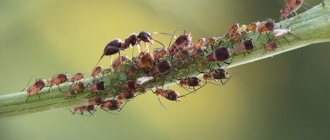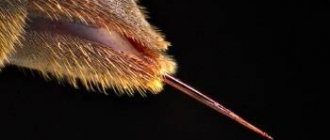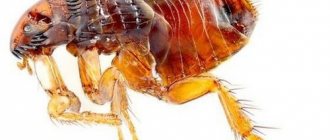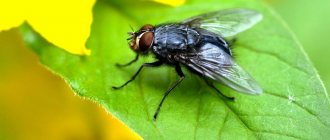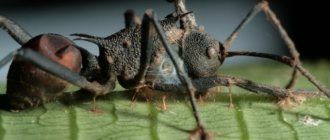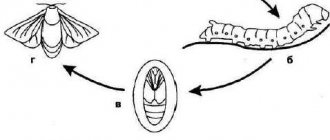Mosquitoes are active depending on the weather and air temperature. In temperate climates, the appearance of mosquitoes begins in May and ends around October. In the northern regions, the peak of mosquito activity decreases already in August or September.
If the winter was snowy and the spring was early, consistently warm and moderately humid, then mosquitoes appear already in April. And if the spring was hot and dry, without rain, then these insects may remain inactive until June. However, mosquitoes do not disappear when the thermometer begins to slowly creep down. These insects have learned to adapt to climate change and find suitable shelters for themselves.
Start and end of the season
For the full development and reproduction of these flying insects, a temperature of at least +100C and high humidity are required. Such conditions appear with the arrival of spring warmth. During this period, the hibernating female bloodsuckers wake up after winter, and their flight season begins.
Only female mosquitoes bite. To successfully lay eggs, they need human or animal blood rich in nutritional components. They digest it in the intestines and synthesize proteins necessary for the development of eggs. In this regard, insects are especially active after waking up.
Drunk on blood
With rising temperatures in the summer months and regular rains, the number of flying insects increases sharply, as the process of reproduction of bloodsuckers proceeds at an accelerated pace.
Mosquitoes disappear when conditions no longer meet the criteria for their life activity. With the arrival of autumn, as soon as it starts to get colder, the number of bloodsuckers decreases. The remaining individuals look for secluded places for wintering.
Mosquitoes will disappear when the first frosts arrive. This means their season is over.
How to fight in winter
Many people wonder how these insects bite in the cold winter if their vital activity is slowed down. You should know that there are urban mosquitoes. They are in a “higher” position.
A favorable environment for bloodsuckers to live and reproduce are damp rooms: basements, sewers, water supply systems. In such places where bloodsucking mosquitoes live, it is quite warm and damp, thanks to which mosquito larvae calmly continue their development.
They easily move into apartments through ventilation pipes. Therefore, many residents suffer from bites of these pests even in winter. To get rid of them, people attach mosquito nets to the places where mosquitoes “come” from. Most often these are ventilation holes.
Many residents use fumigators, various repellers and fly swatters to combat bloodsuckers
If insects have already bitten a person, you can use a spray or cream that helps eliminate the itching.
All these actions only help to stop the mosquito invasion for a while. It is better to solve such a problem on a large scale - to eliminate the cause of pests in the house itself, for example, to get rid of moisture in the basement.
Bloodsuckers in the northern regions
Mosquitoes are widespread throughout Russia. But in Siberia they are found in large numbers. This is due to the fact that one of the important conditions for the life of bloodsuckers is high humidity. And in this region, when the sun warms the tundra in summer, many vast swamps form, where bloodsuckers live. In arid regions, mosquitoes die quickly, even if the air temperature is favorable for their life.
These flying insects, living in the northern regions, have, in the process of evolution, acquired resistance to low temperatures. With the arrival of cold weather, only males die, and fertilized females and larvae overwinter under ice and snow. During this period, they enter diapause, which leads to a slowdown in metabolic processes, resulting in resistance to unfavorable conditions.
General information
A mosquito is a miniature insect that has a pair of transparent wings, six long legs and a proboscis with which it feeds.
The body consists of the cephalothorax, where the internal organs are concentrated. The elongated abdomen serves to concentrate the blood received by the insect from the body of the victim. Mosquitoes are truly unique creatures. They live all over the globe. The only exceptions are the Antarctic latitudes, where the life of a mosquito becomes impossible due to too low ambient temperatures and lack of conditions for food and reproduction. In total, researchers have recorded about 3,000 individual species of mosquitoes.
Night activities
Mosquitoes begin active flight between 20:00 and 22:00 in the evening, and also at 4-6:00 in the morning. It is at this time that the temperature becomes comfortable, atmospheric pressure normalizes, and humidity rises.
Night activity
Females bite more often in the evening, much less often in the morning. The best option is a sleeping person or animal that does not respond to squeaks. In search of prey, females are able to cover distances of up to 50 km. Scientists conducted a study and found that mosquitoes are especially aggressive during the full moon. During this time, they bite 500 times more often than usual.
Color
Scientists from America conducted a strange study that actually turned out to be useful. They tracked the mosquitoes' reaction to colors. They found out what color mosquitoes (and maybe midges) don’t like. As a result of the experiment, it turned out that the insects did not approach people wearing yellow clothes. They are not attracted to all shades of green.
But, mosquitoes love red, blue and black. Due to poor vision, it is easier for them to find dark silhouettes.
Knowing what color mosquitoes like, you can protect yourself from bloodsuckers without repellents. It is enough to choose clothes of suitable shades.
What determines the lifespan of mosquitoes?
The death of these flying insects occurs not only due to the aging of their body. There are other factors on which the lifespan of bloodsuckers depends.
Mosquitoes die from high or low air temperatures. Also, the death of insects occurs as a result of lack of nutrition when plants wither in the fall, since mosquitoes feed mainly on their juice and nectar, and they need the blood of humans and animals only for breeding.
These flying insects also have natural enemies: birds, dragonflies, frogs, fish, spiders. They can also significantly reduce mosquito populations.
The cause of the female's premature death can also be her bloodthirstiness. Females are able to drink large amounts of nutritious fluid. In some cases, the volume of absorbed blood significantly exceeds the body weight of the insect. In this case, the body cannot cope with the load, which leads to the death of the female.
Where do they disappear to?
In nature, the activity of mosquitoes is highly dependent on the ambient temperature. Insects do not tolerate temperatures below 10 degrees Celsius very well, and die at 2 degrees. Therefore, with the first frost, insects cease to exist and disturb.
As for living quarters, mosquitoes do not disappear anywhere, they simply die without food. Males come first, and then females later, even if they have drunk blood. The fact is that strategically important foods for mosquito nutrition are nectar and plant juice, and if such pleasure is not observed in the living room, the female will die in 2-3 days. The presence of indoor flowers significantly prolongs the life of a female mosquito. If she manages to drink blood and become fertilized, she may well lay her eggs somewhere in a damp place under the bathtub, in the underground or in a watered indoor plant.
useful links
Read our article about how ultrasonic mosquito repellers work.
In general, our mosquitoes are not such dangerous insects; the only harm they cause is intrusiveness at night and severe itching from bites the next day. A mosquito bite is nothing more than a microallergic reaction of the body, which manifests itself according to all the rules of this direction:
- swelling,
- redness,
- itching
However, antibodies that are constantly present in human blood are able to suppress the pathological effects of protein antigens in mosquito saliva. But some people, especially those with reduced immune defenses against mosquito bites, may experience more serious reactions that become system-wide - shortness of breath, changes in blood pressure and even loss of consciousness, which resolve with proper treatment.
Facts about flight abilities
The female can boast of special achievements. Female representatives fly far to find a source of nutrition - blood. The speed of a mosquito is 3.2 km per hour. If absolutely necessary, insects fly to a maximum distance of 300 km. Provided that food supplies have been replenished beforehand. To cover such a distance you need to fly about 35 hours.
Flight range is not the most surprising thing. There is no exact data to what height insects can rise. Many experts insist that mosquitoes do not rise higher than 15 m above the ground, which is approximately the 3rd floor of a house. However, there are facts that mosquitoes were found on glass from the outside on the 22nd floor.
The mosquito weighs only 3 g. At the slightest breath of wind, it changes its route. Streams can carry it over long distances, both upward and to the side. Amazing behavior of blood-sucking creatures during the rain.
On a note!
When a drop hits the limbs, the mosquito simply changes its route; on the body, it moves downwards for some time along with the drop. If a droplet falls on the body of a mosquito that is on a hard surface, death occurs. The facts were obtained in laboratory conditions.
Factors influencing life expectancy
Theoretically, under favorable conditions, bloodsuckers can live up to several months. Regardless of gender and species. However, in practice, everything depends on environmental factors: temperature, the amount of food available for daily consumption, climatic conditions in the place of residence, the activity of animals and other insects.
Temperature
The optimal temperature for preserving life for the longest possible time is 10-15 degrees. Anything higher or lower affects the length of the insect's natural biological cycle.
How long do mosquitoes live at different temperatures in a room with a constant temperature level?
- From 10 to 15 °C - about 115-120 days.
- 15-19 °C - 110-115 days.
- 20-24 °C - 55-60 days.
- 25 °C and above - 40-45 days.
This is a rough, approximate calculation. However, due to the high ambient temperature, the metabolism of insects begins to accelerate sharply. Consequently, life expectancy decreases.
How long do mosquitoes live in the wild?
You can safely divide the numbers above by 2-3. Because the natural environment is much more aggressive than the artificially created microclimate of a city apartment or house.
For optimal life activity, it is necessary that the average daily temperature be maintained at a constant level. The danger is the scorching heat. Because it dramatically shortens the life cycle of bloodsuckers. If the thermometer readings are at low levels, the insect can adapt without problems. It goes into suspended animation. Falls asleep without harming himself. As soon as the temperature returns to normal, it wakes up again and is ready for active life.
Food
Nutrition is one of the most important components of the existence of bloodsuckers. The method of feeding and its nature depend on the sex of the individual. The male is a harmless representative of his species. It feeds only on nectar and drinks water. Only the female bites. During periods between breeding, it feeds on nectar. As soon as the mating season begins, she requires blood in a volume greater than her own body weight.
How long do mosquitoes live without blood?
Depends on the moment of egg laying. Theoretically, a female can lay eggs without sufficient blood intake. But in this case, the development and formation of future offspring will take a lot of effort. The mother's own reserves will be used up. Laying eggs without being saturated with blood will lead to death immediately after the natural process. The offspring themselves will be weak and not very viable. Of the total number of eggs, only 5-10% will survive.
If the female consumes blood, she continues to live throughout the subsequent cycle. During this time, she may well survive several more mating periods and give birth several times.
Also in the section: What diseases do mosquitoes carry?
Floor
According to scientists, males initially have a shorter life expectancy. A male mosquito lives 10-20% less than a female. What this is connected with is not known exactly. As experts suggest, this is due to different roles in reproduction, as well as the need to update the genetic material and its diversity in the population.
Activity of natural enemies
Oddly enough, the life of a bloodsucker can end in its mouth or beak. Bloodsuckers have many enemies. These include flies, dragonflies, spiders, bats, swallows and dozens of other creatures.
How many days a common mosquito lives depends on a combination of these factors. In nature, periods vary from several days to several weeks. At home - several times more. However, how long mosquitoes live in an apartment depends on the conditions in the room.
Related articles: Why do mosquitoes bite?
Vegetation
For rest and shelter, insects use the dense foliage of trees, tall grass, and shrubs. They are attracted to various weeds. But there is a tree that mosquitoes do not like; they are afraid of it. This is a tree with a pungent odor of fruits or inflorescences.
Mosquitoes avoid:
- Rowan
- Bird cherry
- Walnut
- Elderberry
- Conifers.
There are plants that lure insects with their scent and destroy them. These are plants that are predators - butterwort, sundew, flycatcher, dewweed.
Flowers that mosquitoes do not like are calendula, geranium, ageratum.
Insects do not like the smell of grass with a pungent aroma. Mosquitoes and midges do not like this. For the same reason, mosquitoes do not like the smell of vanilla. Vanilla-based folk remedies for repelling mosquitoes have been successfully used, which can be used both at home and outdoors. These are essential oils, sticks or confectionery powder. Mosquitoes do not like vanillin, but use it with caution; you may develop an allergy to vanilla.
Facts about mosquito squeaks
Everyone is familiar with the squeak of a mosquito, which sometimes turns into a rumble. The last sound is created by the male, but the female makes squeaks of different ranges. But few people have thought about why mosquitoes squeak. With the help of ultrasound, the pest is able to warn others of danger, notify about the presence of a victim, attract a partner for fertilization, or scare him away if unnecessary.
A young female squeaks much more intensely to attract a male. When mating occurs, the female does not need attention and makes scaring sounds. By a certain sound, mosquitoes determine the approach of enemies - dragonflies, bats. Based on this, people created an ultrasonic repeller.
Interesting!
Mosquitoes squeak not with their mouthparts, but with their wings and halteres. The wings are extremely thin, small, flapping with great speed, which when they come into contact with air does not create a buzzing sound, like many insects, but an annoying thin squeak.
Mosquito
Facts about the appearance features
The mosquito weighs on average 3 g, body length from 4 to 12 mm. Three pairs of long legs have claws and suction cups that help the insects hold on to any surface. The female's oral apparatus deserves special attention.
A simple proboscis for sucking blood has a rather complex design. It can only be seen with high magnification. The oral apparatus is formed from two lips and jaws - upper and lower. There are mandibles on both sides, a total of 4 pieces. They are used by mosquitoes to deliver their bite. He pulls back his lips and inserts 6 needles under the skin. Two of them have up to 50 teeth, which are formed thanks to dense, pointed bristles.
Only after such a complex process with a bite does the female insert her proboscis and begin to drink blood. She tries to consume all the amount she needs at one time.
Facts about Bite Activity
Facts about mosquitoes for children - an insect bites about 15 times in one night. An experiment on the Canadian tundra showed that in a minute young mosquitoes bite the body, arms, legs, and neck about 9,000 times. At this rate, a person risks losing half of his blood in 2 hours.
Mosquitoes sleep all winter, crawling into crevices and forest floors. But as soon as you bring them into a warm room, they instantly wake up. Fertilized females go into hibernation and immediately lay eggs when the weather warms up. Active mating season can be seen in April-May. Mosquitoes gather in groups, mating takes place on the fly.
Small ordinary mosquitoes are amazing creatures that never cease to shock people with their abilities.
Habitat Facts
Insects are active at a temperature of +12 degrees Celsius. To prolong the species, a moist environment with standing water is needed - puddles, swamps, lakes, ponds, damp soil. Representatives of the population are found throughout the world, with the exception of mountainous areas, areas covered with eternal ice. Mosquitoes live and breed in forests, near swamps, and also in the basements of multi-story buildings.
On a note!
Over time, mosquitoes have adapted to urban areas and are even able to lay eggs without fertilization.
